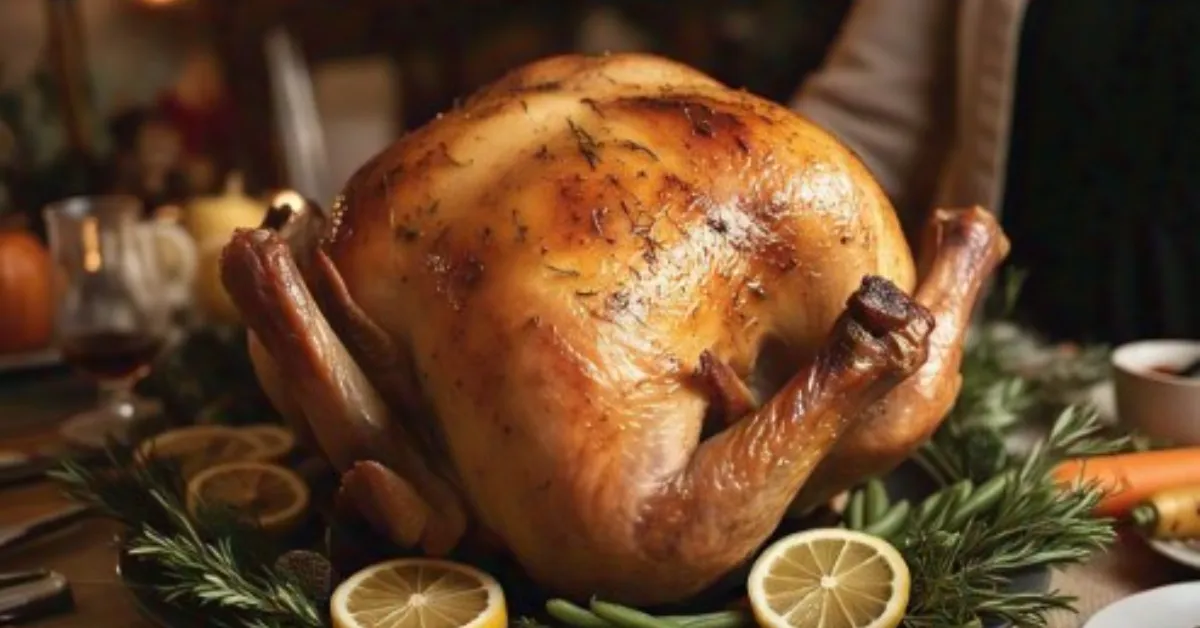Perfectly Preparing And Cooking A Whole Turkey
Not only do they make the perfect centerpiece of many holiday meals, but a perfectly cooked whole turkey can take your gathering from ordinary to extraordinary. But for home cooks, in particular, preparing this iconic dish can be daunting. Don’t fear: given the right techniques, you can serve up the perfect turkey.
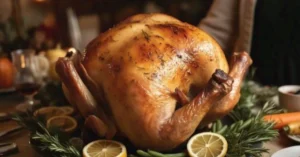
This guide takes you by the hand and walks you through the fundamental decisions you should make, ensuring you pick the right bird, and how to become experts in bringing, seasoning, and roasting.
With foolproof methods to turn out a golden brown turkey with juicy meat and crispy skin, you’ll learn this. Ready your main dish here for a whole turkey that’s flawlessly prepped and ready to impress your guests and create lasting memories around the dinner table. I have 20 years of experience in cooking. So you can trust me.
The All-American Tradition of Cooking Turkey
American culture is so rooted in the cooking of turkey for special occasions, especially for Thanksgiving. It’s a custom that goes back to the early colonial period when wild turkeys abounded in the New World.
Preparing a whole turkey as the centerpiece of the holiday meal has become something of a tradition in the United States and is linked over time with the memories and rituals of family gatherings and celebrations.
From Pilgrim Times to Modern Tables
Turkey’s versatility and symbolism tell their own story of a forest fowl on its path from the forest to the festive favorite. Right from the start, the bird caught on as an early settler’s reliable food source, and it gradually moved to the top of the Thanksgiving feast.
Millions of Americans today continue in this honored tradition, and each family has elaborated upon its unique recipes and preparations.
A Culinary Challenge and Reward
A whole turkey makes for a rather daunting challenge for any home chef and also an opportunity. To roast the bird right takes time and effort and requires some careful planning. But since the reward of serving up a perfectly cooked turkey to hungry family and friends is worth the effort, it perpetuates a tradition that is so closely associated with America; it leaves an unforgettable memory as well as helps to maintain that legacy.
Choosing the Right Turkey: Fresh vs. Frozen
When planning what will be on your Thanksgiving table, selecting the perfect turkey is imperative. Fresh vs. frozen birds can be hugely deciding factors in how you will cook the bird and what you’ll have for dinner.
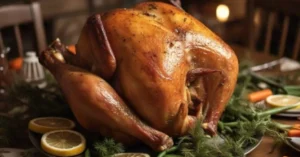
Fresh Turkeys
Several advantages come with fresh turkeys. Cooking Frozen: They’re ready to cook without thawing and save you valuable time. But in doing so, these birds improve flavor and texture, because these are birds that have not been frozen. It is safer to cook a fresh turkey than a frozen turkey, and fresh turkeys usually cost more.
Frozen Turkeys
On sale, frozen turkeys are a more convenient and budget-friendly option. You can buy them well ahead so that planning meals is easier. Freezing the bird keeps it intact, but it naturally takes a long time to thaw about a day for each 4 to 5-pound bird.
Read More: Traditional Italian Easter Pie And Easy Recipe
Making Your Decision
When choosing, consider your budget, preparation time, and initial flavor profile. For convenience and cost, a frozen turkey may be just the thing. If you’re willing to pay more for flavor and texture, a fresh turkey is an option.
Whatever you pick, just be sure you handle and cook them appropriately for a safe, delicious holiday centerpiece.
The Essential Tools You’ll Need for Success
When it comes to preparing a turkey, one of the more critical necessities to compile is your tools. Here are the must-have tools for your Thanksgiving feast:
Roasting Pan and Rack
Get a good, sturdy roasting pan with a removable rack to invest in. This is to promote even cooking and also give the bird room for air to circulate and stay crispy skin. Pick the type of pan that’s big enough to hold your turkey and with some room to spare.
Meat Thermometer
If you are anything like me, then a good, reliable meat thermometer is non-negotiable. Despite this, it is the only method that offers accurate information on the internal temperature of your turkey, securing a minimum of 165 F (74 C).
For faster and more accurate measurements, use an instant-read digital thermometer.
Basting Tools
Using a quality baster or brush is a sure way to keep your turkey from browning too much and full of flavor. Silicone basting brushes won’t shed bristles and are easy to clean.
Carving Set
A sharp carving knife and fork will help slice your turkey so easily. When looking for a set, ask that it comes with ergonomically designed ergonomic handles for control and comfort of carving.
Now that you’ve got these essential tools at your disposal, you’ll be ready to create a showstopper of a turkey, both safe to eat and good to eat.
Prepping Your Turkey: From Thawing to Trimming
Thawing Your Turkey Safely
First, you need to thaw your turkey correctly. Time for thawing in the refrigerator is generally 4-5 pounds, although larger pieces of flesh may require 24 hours for the same weight. In particular, never thaw your turkey at room temperature, where it could spur bacterial growth.
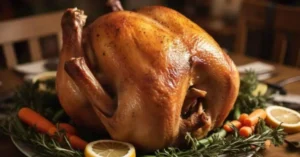
If you’re strapped for time, you can use the cold water method or simply submerge your wrapped turkey in cold water for 30-minute intervals.
Removing Giblets and Trimming
Remove the giblets that come with the turkey’s cavity once the turkey has thawed. They may be used in gravy or stuffing. Then trim off any excess fat around the neck and the cavity. To get crispy skin when roasting, pat turkey dry with a paper towel, inside and out.
Read More: Perfectly Preparing And Cooking A Whole Turkey
Brining for Flavor and Moisture
It is also thought that it would help bring additional flavor and juiciness to your turkey. Make a salt, sugar, and aromatics solution, such as herbs and citrus.
There are 8 to 12 hours before cooking to submerge the turkey. For time-pressed cooks, a dry brine with a combination of salt and spices applied directly to the skin also works.
Bringing 101: The Secret to a Juicy Turkey
Brining is how anyone with a turkey increases the odds of eating a juicy, well-basted bird for Christmas dinner. Instead, this technique consists of soaking the bird in a saltwater solution enriched with herbs and spices to infuse flavor and moisture very deep into the meat.
The Science Behind Brining
Then when you submerge a turkey in the brine, osmosis happens. When the meat is cooked, the salt solution harshes the muscle fibers to help keep the meat wet. Not only does this seasoning process season the turkey all over, but it also creates a tender and flavorful turkey.
Wet vs. Dry Brining
Space-saving traditional wet brining turkey has the turkey in a liquid; dry brining provides the wet brining effect yet means you don’t need to submerge the turkey in liquid. Rubbing salt on your skin and then letting it sit on your skin for 24-48 hours is this method.
Both techniques yield good results, but dry brining is easier to clean up and potentially crispier skin.
Brining Tips for Success
- Use kosher salt for better and more flavorful dissolution.
- You can also add aromatics such as bay leaves, peppercorns, and zest from citrus.
- Bring the turkey to when it’s fully thawed so it absorbs as much as possible.
- After wet brining your turkey, rinse thoroughly to remove all excess salt.
That’s why you remember bringing your ticket to a show-stopping, juicy turkey that will have your guests raving.
Seasoning Your Turkey: Rubs, Marinades, and Herbs
Crafting the Perfect Rub
You want your turkey to be mouthwatering. You have to create a flavorful rub. Turn to kosher salt, black pepper, dried herbs like thyme and rosemary, and a bit of paprika to add color. Massage this mixture all about and under the skin of the bird for the best flavor infiltration.
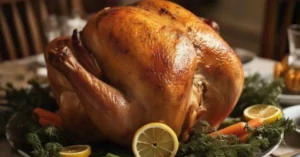
Marinating for Moisture
So for a juicy turkey that sweats out more taste, you may need to marinate your turkey for the night. Marinading the meat and adding flavor to it through cooking, the meat is first brined using salt, sugar, and aromatic herbs brine.
Or else marinate the meat with buttermilk to give it an extra flavor and tenderize the meat.
Fresh Herbs for Aromatic Bliss
Fresh herbs aren’t to be underestimated. In the turkey cavity, stuff sprigs of sage, rosemary, and thyme, plus lemon halves and garlic cloves. It makes the meat smell from the inside out, and when it does, you get an aromatic blend that’ll have your guests raving.
Stuffing vs. Dressing: What Works Best?
The a continued debate over whether to stuff or dress your turkey when it comes to preparing your turkey. Both choices have their merits, but learning the distinctions could help you pick the greatest decision for your infrequently shaped feast.
Inside the Bird: Stuffing
Stuffing is a traditional dish, usually cooked in the turkey cavity, that absorbs juicy flavor from the bird as it cooks. A moist, savory mixture, this method is many people’s idea of the perfect holiday tradition.
But be sure to check the stuffing’s temperature; it should be 165°F (74°C) to avoid foodborne illness.
On the Side: Dressing
Then the dressing is cooked separately in a baking dish. With this method, there’s more control over how long you cook it and how it will turn out. Crispy top and can hold more makes it the preferred choice. That also means cooking the dressing separately helps cut down on the overall roasting time of your turkey too.
Ultimately, the decision is about personal preference and if you’re doing it at home, food safety. Whatever you do, those are ways to add a delicious element to your Thanksgiving table.
Cooking Techniques: Traditional Roasting to Modern Alternatives
Classic Oven Roasting
For many, roasting a turkey in the oven is still the ‘time-honored’ method. To begin with, your oven is preheated to 325°F (165°C). Season the turkey breast side, place it on a rack in a roasting pan, and the breast side up.
Allow 15 minutes per pound (about 1½ hours for a 4-pound bird) or until the measured internal temperature reaches 165°F (74°C) in the thickest part of the thigh. Toss that turkey every 30 minutes in its juices to keep it from drying out and to help ensure golden, crispy skin.
Innovative Cooking Methods
For those seeking alternatives, consider trying:
- Deep-frying: Put the turkey in hot oil for crisp on the outside and juice on the inside.
- Smoking: We impart smoky flavors when smoking with wood chips in a smoker.
- Spatchcocking: For even, faster cooking, flatten the bird.
Every technique has its own advantages; enhanced flavors and shortened cook times, just to name a few. No matter how you achieve it, be sure to check food safety with a meat thermometer and make sure you are done by whichever method you choose.
Basting and Monitoring: Keeping the Turkey Moist
The Art of Basting
Do yourself a favor and learn to baste your turkey. Open the oven carefully every 30 minutes and baste (or use a large spoon) the bird with its own juices or melted butter. It’s this oil that adds superior, deep golden, crispy skin while ensuring the meat stays tender and succulent.
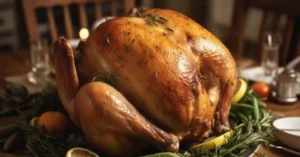
Temperature Monitoring
So always make sure to check the temperature of your turkey before removing it from the oven, microwave, or refrigerator. Put the food thermometer into the thickest part of the thigh without touching the bone.
It’s done, and it’s over when the turkey is cooked, or when it gets to a temperature of 165F or 74C. What is required to bear in mind is the fact that the dish will keep on rising in terms of temperature after it has been extracted from the oven, but this can be taken out a little way off the particular figure.
Adjusting Cooking Time
Expect your cooking time to have to be altered according to how fast the turkey is cooking. If it is browning too quickly, place the entire tin loosely with aluminum foil to slow down the process.
However, if it isn’t cooking as fast as you wanted, then you might want to drop the oven temperature a little. The only way to avoid this is by taking the pot off the heat; you can never be very precise with recipe times; always opt for the safe internal temperature instead.
Resting and Carving: The Art of Presentation
Allow for Proper Resting
When your turkey gets golden and fragrant coming out of the oven, don’t cut it up right away. It’s important to allow the bird to rest for 20 to 30 minutes. It’s a pause that allows the juices to mingle back through the meat, keeping each bite nice moist, and flavorful. Put a bit of foil over the turkey to keep it warm during that resting period.
Master the Carving Technique
Once the turkey has rested, you are ready to lead your kitchen guests to your carving table. First, cut off the legs and thighs; then, pull off the wings from the body. For breast meat, slice long and thin, parallel to the breastbone. This technique gives that crispy, seasoned skin to every portion, and it’s attractive, too.
Create an Appealing Presentation
Carve your turkey, arranging the white and the dark meat in turns for effect on a large platter. The caramel is beautiful enough, but you can garnish it with fresh herbs such as rosemary or thyme for an extra pop of color.
Presentation is everything; a beautifully set table can make your whole meal, even if your turkey is perfectly cooked, become the centerpiece.
Common Mistakes to Avoid When Cooking a Turkey
Overcooking the Bird
Overcooking a turkey is one of the most common mistakes that take place when you are putting the turkey together. It can dry out the meat, giving it a dry, tough taste we wouldn’t want.
To prevent this, rely on a safe means of checking the temperature of the inside. When it is done, the turkey has reached 165°F (74°C) in the thickest part of the thigh. If you remove the bird from the oven, remember that it will continue to cook a little.
Skipping the Brine
Leaving your turkey unbrined is a flavor and moisture miss. Soaking the bird in a salt solution, usually with added herbs and spices, is what brining means. That process ensures the turkey is cooking and moisture is retained. Even a quick 4-6 hour brine can make a difference if you’re short on time.
Stuffing the Turkey
Stuffing your turkey is traditional, but it can also cause uneven cooking and some food safety concerns. To be safe, the stuffing must reach 165 degrees but more often the turkey. Instead, cook your stuffing separately in a casserole dish.
So you can perfectly cook them both while getting those extra-crispy edges to your stuffing.
Perfect Pairings: Side Dishes and Gravy Tips
Classic Accompaniments
Side dishes are a must for a turkey dinner. Roasted bird is perfect plus creamy mashed potatoes, tangy cranberry sauce, and stuffing. If you need a little green in your life, go for a roasted Brussels sprout or a crisp salad. Don’t leave out the dinner rolls for the gravy soak.
Gravy Mastery
Gravy, my dear turkey feast. If you’re talking gravy, why not pool your turkey feast with a delicious, rich, flavorful sauce? Deglaze the roasting pan with white wine or with stock, scraping up all those yummy browned bits.
Making a roux: first whisk in flour, then slowly add the turkey stock by the ladle, stirring continually to prevent lumps. Herb season some with thyme sage or cream for extra lusciousness. After all, the difference between a slick, smooth gravy and a crappy Thanksgiving dinner is precisely that.
Storing and Reheating Leftovers Safely
Proper Storage Techniques
After eating your Thanksgiving feast, you need to store leftovers properly for food safety and quality reasons. If you’re cooking your sides and turkey, refrigerate within two hours of serving. If the amount of cut seafood is large, divide large portions into smaller, shallow containers so they quicken in cooling.
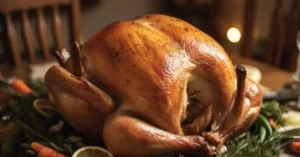
Store in airtight containers or wrap tightly with aluminum foil or plastic wrap. Put a date on each container as a means of tracking freshness.
Safe Reheating Methods
Reheating turkey will kill any bacteria, but you must ensure that the turkey reaches 165°F (74°C) while reheating it. Verify with the use of a food thermometer. Cover foil over it to retain moisture and reheat in the oven at 325°F (163°C).
Rotate and microwave on medium power for even heating, or microwave on medium power. Don’t reheat more than once, because it can cause foodborne illness.
Maximizing Leftover Freshness
Fresh, thawed turkey may be stored in the refrigerator for 1 to 2 days and in the freezer for 4 to 12 months. Frozen leftovers can be stored for up to 2 months after being frozen. IFrozenturkey can be stored for up to 4 months.
Thaw in the refrigerator, never at room temperature, ready to use. This is especially true when in doubt; throw it out to guarantee food safety.
A Turkey to Remember: Wrapping It All Up
And as you sculpt around your whole turkey that you perfectly cooked, make sure to enjoy the fruits of your labor. That golden brown skin, crisp and glistening, leads to the tender, juicy meat that bursts with flavor. And your preparation and cooking are paying off; the centerpiece is going to impress your guests and give them a meal they’re going to remember.
Finally, remember that the details lead to success. Finally, selecting the right bird to bring, seasoning it, and roasting it right is all part of creating that final result. And remember to rest your turkey before carving. Rest is an important step because that rest lets the juices move around so your bite is as moist and delicious as it should be.
Surrounded by loved ones and the smell of your perfectly cooked turkey, you can feel good that you’ve got the art of this classic holiday dish down. But not just a delectable meal; you’ve also made the coordinates of that togetherness and celebration by bringing us into the atmosphere.
Conclusion
You’ve seen what is involved in preparing and cooking a whole turkey, and, as you have just seen, it takes care and planning. If you adhere to these steps from choosing the right bird and how to properly thaw, season, and roast it, you’re sure to serve an amazing centerpiece for the holidays.
Be sure to use a meat thermometer so you know you are getting the perfect level of doneness and how to be certain food is safe. With practice, you will get the knack of cooking a whole turkey so that it comes out as juicy as possible.
And your guests will surely savor each bite of you as they enjoy every single flavor and bite. Now that you know all that, it’s time to implement these techniques and get yourself a memorable turkey dinner.
Frequently Asked Questions
How long should I thaw a frozen turkey?
Depending on the size of your turkey, allow 2-3 days (or 24 hours for each 4-5 pounds of turkey) in the refrigerator to thaw. In particular, a 15-pound bird is going to take about 3–4 days to finish thawing. Do not thaw a turkey at room temperature, which encourages bacterial growth.
What’s the ideal internal temperature for a cooked turkey?
As long as the turkey’s internal temperature has reached 165°F (74°C) in the thickest part of the thigh, far away from the bone, the turkey is safe to eat. And use a meat thermometer for accuracy. Carve the bird after 15-20 minutes have passed so its juices can redistribute.
How do I prevent the turkey from drying out?
Brining your turkey helps retain moisture. Basting the bird every 30 minutes while cooking and tucking it under a piece of foil if it browns too quickly will also keep it from drying. Don’t overcook, which is a frequent reason for a dry turkey.

Hello! My name is Wahab Khan. I, having over 20 years of culinary experience, bring both my knowledge and passion to each Recipe featured here. I create delicious, accessible dishes for beginners and seasoned cooks alike, and think that good food can help connect people. My recipes combine timeless techniques with stellar new spins, allowing readers to master the everyday flavors of the World.
